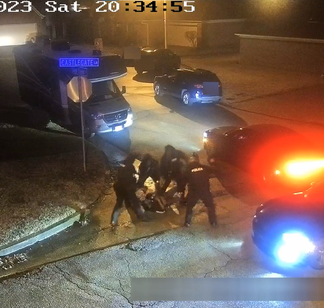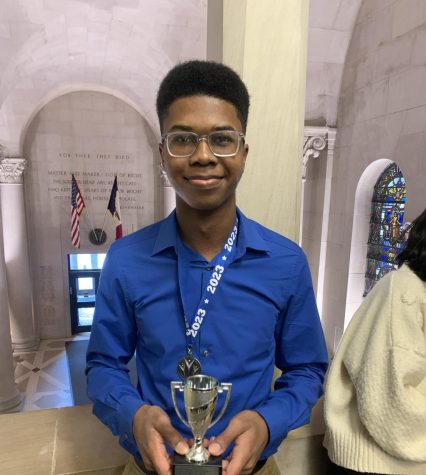
On Jan. 7, five police officers beat an unsuspecting black man named Tyre Nichols into critical condition after a traffic stop on Jan. 7. He died of his injuries three days later.
This was not the first time an act of police brutality had been committed against a black man. Far from it. However, what was shocking about this case was that the officers were also black.
While the nature of internalized racism is complex and it is possible that these officers still had some bias, many are still left confused. This case clearly shows that, while it is extremely important, race is not the only factor in acts of police brutality and that the overall system must be changed.
Although the origins of problems in policing can be traced back to slave patrols in the South, more recent events have impacted these problems greatly. In 1969, Stanford psychology professor Phillip Zimbardo conducted a study on vandalism. He parked two Oldsmobiles, one in the South Bronx and another in Palo Alto, California. As Zimbardo expected, the car in the South Bronx was vandalized quickly. What he did not expect was that these vandals were from a well-to-do white family.
From this experiment, he drew the conclusion, “Conditions that create social inequality and put some people outside of the conventional reward structure of society make them indifferent to its sanctions, laws, and implicit norms.”
The Palo Alto car, however, was left untouched after a week. Seeking prime vandalism, he took the car back to the Stanford campus so he and his students could break the car’s windows with sledgehammers. In his words, Zimbardo and his students “got carried away.”
They damaged the car beyond any hope of repair and a few onlookers even joined in once they were sure the car could have no remaining monetary value. Afterward, Zimbardo deduced that anyone, even “respectable” citizens such as Stanford researchers or a well-to-do white family, can fall victim to the mob mentality.
In 1982, James Q. Wilson and George L. Kelling, researchers of political science and criminology, wrote an article for The Atlantic called “Broken Windows.” The article grossly misinterpreted Zimbardo’s 1969 vandalism study to make the assertion that “one unrepaired broken window is a signal that no one cares, and so breaking more windows costs nothing.”
Essentially, they asserted that unless one crime is punished with extreme severity, soon everyone will be committing crimes. The problem with this assertion is that it ignores the morality and social conditioning of the average citizen. In Zimbardo’s study, the onlookers joined in once the car was completely totaled, not once a single window was broken.
Even though Zimbardo did not draw any of the conclusions that Wilson and Kelling claimed he did, the broken-windows theory has taken hold in the American policing system.
Policing started to become more aggressive and militarized, cracking down on minor offenses with major force. One of the many aspects of this militarization of the police is the attempted expansion of the police force.
Expanding the force is not inherently a negative action, but the consequence is often that hiring standards for police are often lowered. Ironically, people with felony convictions and misdemeanors are often hired for the job of law enforcement officer. “There are people in the profession who should probably find another profession… Watching those videos? There’s no police happening in those videos. That’s just someone being beaten,” said Pleasant Valley School Resource Officer Jamey Fah.
It’s easy to dismiss the impact that one “bad apple” in a police department can have, but a 2019 study in the scientific journal Nature Human Behavior warns against this mindset. It states that a 10% increase in the number of officers with prior misconduct in a given group (i.e. a “bad apple” is added to a group of 10) is followed by almost an 8% increase in the chances that other officers in that group will commit an act of misconduct.
Unfortunately, one bad apple can infect an entire tree, as was the case with the officers who killed Tyre Nichols. As a black woman in America, Pleasant Valley student Jasmine Brown has been forced to confront the reality that some officers are corrupt for her entire life. “It’s less about keeping the place safe, and more about their control over people. They want to see how far they can overstep their power and authority over people,” lamented Brown.
To make matters worse, police unions often prevent police chiefs from firing officers who commit acts of misconduct. A 2017 Washington Post report found that 1,800 officers had been fired for acts of misconduct from 2008-2017, but over 450 of these officers were then rehired. This rehiring process is overseen by supposedly objective arbitrators, but Loyola University Chicago criminal law professor Stephen Rushin studied 650 police union contracts in 42 states and found that over half of them allowed police officers or unions to select the arbitrator.
Police chiefs are left powerless against their own unions, and are often forced to put bad officers back on the streets. These unions have far overstepped their original purpose of negotiating fair pay and hours for officers, and have now become tools for perpetuating a system of injustice.
The rush to hire unqualified cops is based in fear, not fact. Many local government officials believe that the dwindling police force will be unable to handle crime, but the number of police nationwide from 1997 to 2016 decreased by 10.33%. This was met with a staggering 37% decrease in violent crime, which shows that police numbers are not the only thing that can reduce crime.
The New York police department is far from perfect, but once again, crime actually went down when New York City reduced the number of police it had on hand. Rather than just hiring more police, they calculated the amount that would actually be needed every 24 hours by studying 911 calls. That way, only the most qualified cops got the jobs, and officers with prior misconduct allegations weren’t needed.
There’s still a long way to go in the fight for an end to police brutality. “It’s a really tough time right now for a lot of people, and in certain communities, I can understand and appreciate how it would be hard,” says Fah. While people of color are disproportionately affected, regulation is an issue that all people should care about.








